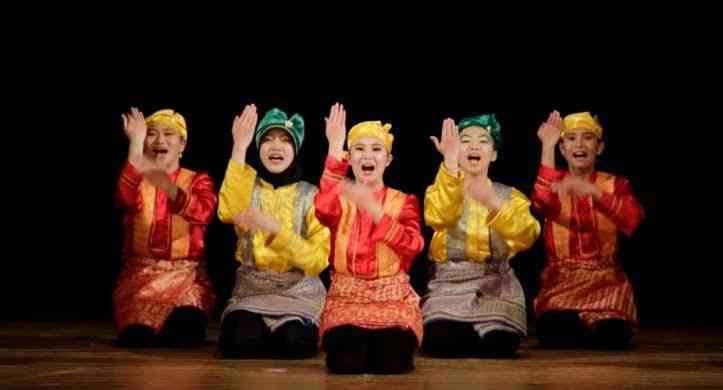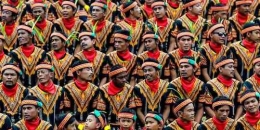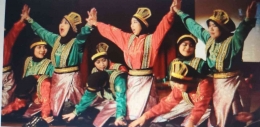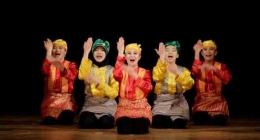SAMAN DANCE
SAMAAN DANCE AS A RELIGIOUS EVENT
Saman dance is a dance originating from the Gayo tribe and is usually performed in an important celebration at a traditional event. The poetry in the dance also uses Gayo languages. In addition, this dance is also often performed when celebrating the birthday of the Prophet Muhammad.
The name of the dance "Saman" is derived from one of Aceh's great scholars, namely Sheikh Saman. Some histories state that Sheikh Saman, a scholar from the Gayo tribe in Southeast Aceh, was the one who later discovered and founded the Saman dance. Saman dance is one of the media to convey messages or da'wah. This dance reflects education, religion, manners, heroism, cohesiveness and togetherness.
HISTORY OF SAMAAN DANCE
This traditional dance from Aceh was created by a scholar in the XIV century AD, namely Sheikh Saman. Saman dance originated in the Gayo highlands, which administratively covers the Aceh Tengah district. At the beginning of its development, this dance was used as a medium for preaching to the local community. At that time before the dance was performed, traditional leaders would give advice to the audience as well as the players themselves.

UNIQUENESS OF SAMAAN DANCE
Saman dance is synonymous with a thousand-motion dance, because the movements are so dominating. Saman dance is performed without the accompaniment of musical Nashwa ayu Anastasia, Maya manda zega, Fransicus Sion Manalu. Sastra Inggris, Universitas Pamulang.
instruments, but using the voices of the dancers and their applause which is usually combined with hitting their chest and groin as synchronisation and throwing the body in various directions. In their performance, Saman dancers are guided by a leader commonly called the Sheikh. Saman dancers and Sheikhs must be able to work well together to create harmonious and compact movements. Saman dance uses the Gayo language which is sung directly by the dancers. Usually the one who sings this song is a dancer who is in the centre. Saman dance is performed in groups of at least seven people. It can also be up to tens or even hundreds of people, as long as the number is odd.
SAMAAN DANCE MOVEMENTS
Saman dance has several elements of movement, namely hand clapping and chest clapping. This movement is in the form of shaking, kirep, lingang, and surang-surang. Other movements of this dance include two rows of dancers singing while clapping and other dancers harmonising the movements. In addition, there are also dominant hand movements. There are various kinds of hand movements, such as cilok (light movements of the fingertips), cerkop (both hands together and in the same direction), and tepok (clapping movements in various positions).
Every Saman dance movement has a deep meaning and philosophy. Initially, Sheikh Saman created this dance movement as a means of dhikr to Allah SWT. This can be seen in the rules of motion and body attitudes that accompany the movements. Saman dance is also often used as a medium for delivering messages (dakwah). This dance reflects education, religion, manners, and heroism. This can be seen from the songs and poems in Saman dance which contain da'wah values and advice. In addition, every movement of Saman dance also has a certain meaning.
This movement can be seen when the dancers have to sit in a straight line to the side while marching. This is then a symbol of humans as social creatures. Meanwhile, in the movement itself, there is also a symbol as a tribute to the prophet Muhammad SAW. The sitting pattern used is the foot resting, like sitting between two prostrations. In this case, Saman dance symbolises Muslims who are praying.

The purpose of this paper is related to the values contained in the Pancasila course.
The dance samaan is an example that is related to the Pancasila precepts of paragraph 5, namely in the form of social justice through the meaning of the line pattern, namely the existence of a good and fair relationship between fellow human beings and also the application contained in it such as the samaan dance which contains many meanings through dances that are used as religious da'wah dances to invite religious people always to remember God.
Dosen pengampu Dr. Yatti Rosmiati. M. Pd.
Nashwa ayu Anastasia, Maya manda zega, Fransicus Sion Manalu.
Pendidikan Pancasila, Fakultas Sastra Inggris, Universitas Pamulang.
Baca konten-konten menarik Kompasiana langsung dari smartphone kamu. Follow channel WhatsApp Kompasiana sekarang di sini: https://whatsapp.com/channel/0029VaYjYaL4Spk7WflFYJ2H








